Genre: Shooter Developer: Sega Publisher: Sega Players: 1 Released: 1987
“War. Huh. Good god, y’all. What is it good for? I’m asking for a friend.” Despite how violent and chaotic our instantaneous global media can make the world appear, we’ve never been more at peace. It’s nice. I get to play video games instead of seeking shelter from bombs, hiding in the trenches, or becoming a lead farmer like in all those war movies. My city is still violent enough to where getting shot is a real possibility once I leave my house, but I truly know nothing about the horrors of living through war. I wish Opa-Opa could have been spared such a life as he has clearly seen some things going into Fantasy Zone II: The Tears of Opa-Opa.
After finding out that his father O-Papa was the one leading the Menon invasion of the Fantasy Zone after forcing the collapse of the interplanetary monetary system, Opa-Opa has to cope with finding out that his father is basically giant living spaceship Rick Sanchez. After wallowing away ten years in various shoegaze bands, Opa-Opa finds himself defending his home from a cadre of Blackhearts (re: video game bosses) bent on taking over the city. Opa-Opa understands that there must be a mastermind behind the invading force who is not also his father… but who? Only one way to find out! As Opa-Opa’s dearly departed friend and part-time Harrier Arnold Palmer once said, “Welcome to the Fantasy Zone. Get ready!”
Man, do Fantasy Zone games have an oddly heavy background story or what? What happened to a good ol’ “blast the ugly aliens” plot for a petty excuse to shoot all manner of stuff? The seriousness of the tale definitely clashes with the cheerful, colorful world which has become the Fantasy Zone series’ hallmark. I’m telling you the fake news media is lying about the ugliness of war, because how can war be hell when it looks this cute? The game opens up to a super bright garden bed full of pink and yellow flowers with multiple rainbows hopping from cloud to cloud in the background. From there the game takes us to pastel pink worlds, icy crystalline landscapes, and cacti covered dunes. Fantasy Zone II treats players to some of the most vivid graphics available on an 8-bit system. The worlds do look flat — no parallax scrolling nor any other environmental hazards or effects — but they are more interesting to look at than the typical blank expanse of space or generic tiled corridor so often seen in shooters of this era.
As in the previous game, the goal of each stage is to shoot all the big enemy spawning bases in order to reveal that planet’s boss. Fantasy Zone II is still a free-scrolling horizontal shooter, but now each planet stage is divided into a number of connected “scenes,” each with its own unique backdrop. Movement from scene to scene is accomplished by uncovering warp panels hidden behind the enemy bases. Opa-Opa has to explore each of these rooms to find all of the targets, making for a more involved game. A map like that found in other objective-based shooters with free movement such as Defender, Chopper Command, and even the arcade Fantasy Zone would have been welcomed here. While the bases aren’t exactly hiding, with up to five scenes to explore per stage, the endless scrolling and pressure from enemies can make it easy to get lost.
At least you won’t lose track of the store this time around. Just as in the first Fantasy Zone, Opa-Opa arms himself with guns and bombs he purchases from a store, but this time the store is in a fixed spot on the background instead of floating around on a level. Apart from that the gameplay is largely unchanged: shoot enemies to earn money and use the money to buy powerful but short-lived upgrades. Want to upgrade your pea shooter to a spread shot? You can, but it’ll cost you, and after enjoying your half a minute of winged death, you’ll have to buy it again (but now with an added markup). Weapons can only be selected at the store, too, so you can’t stock up on lots of goodies and have them daisy chain so that you stay lethal once the first weapon runs out. You’ll have to plan ahead a bit and make the most of your limited funds and weaponry if you hope to survive the challenges ahead.
Flying through the Sega Master System’s impressive palette, our little winged spaceship is inundated by all manner of enemy waves. Bouncing pink jellies and bright-eyed snails, flying sea turtles and winking tornadoes, and cute jumping cannons and hopping springs don’t look dangerous, but all it takes is one hit to ruin Opa-Opa’s day. Some of these tiny threats are birthed from the large sedentary bases Opa-Opa has to destroy, but most come of the edges of the screen. Each stage boasts four or five types of enemies, and they are relentless, particularly in the later stages. There can be a bit of slowdown during the more hectic moments as you’ll often find yourself getting slammed by two enemy waves at a time, but the game holds up well considering how busy the screen can get. I’ve always got a kick how Opa-Opa can literally walk through the stages with his little spaceship feet, but that’s not really recommended given his slowed movement and possibility of enemies launched from the bottom of the screen. Until the boss decides to show up, it’s best to stick to the middle of the screen.
The Blackhearts make an impressive entrance, each one filling the screen and bringing something new to the table. The giant log Opa-Opa encounters after clearing the first planet casually floats along the side of the screen but forces Opa-Opa to navigate a maze of smaller logs to survive. Later we’ll fight an expanding hamburger-like thing, a scaling (not real scaling) blowfish, and a very well animated giant column with a spinning head which spits more shots than the system should allow. I’m not crazy about a couple of them such as the aforementioned blowfish as they feel more like technical achievements than fun gameplay challenges, but most of these are excellent. Being a late ’80s game, you already know players will be fighting them again during the closing boss rush, but the quality is good enough to let it slide.
Sega Master System players capable of enjoying FM sound from their machine will notice a big bump in quality listening to the game’s soundtrack as well. Those without FM… Well, there’s still music in the game, but the shrill notes can really scratch your ears. The melodies are perfectly fine, but they’re nigh unlistenable without the FM chip rounding out the sound. Same goes for the sound effects, and if you haven’t modded your system for FM sound, Fantasy Zone II will give you the excuse you needed to get off your butt and install the chip. I’m only glad I can enjoy the game the proper way now, because who knew any better back then?
Who also would have ever thought that the game would see an arcade-minded remake some 20 years later? Japanese developer M2 took this game – Fantasy Zone II began its life as a console title with the later arcade release being pretty much the same game – and remade it for the PlayStation 2’s Sega Ages Vol. 33 Fantasy Zone Complete Collection. Re-imagined strictly as a System 16 arcade game of the era, the remake is noteworthy for ditching the multi-room layout of the SMS original, instead constructing the game around “bright” and “dark” worlds which the player shifts between via the portals (kind of like Sonic CD). The M2 remake is a beautiful game, and the streamlined gameplay, amazing revised boss battles, and other tweaks can make it tough to go back to the original.
That wouldn’t be fair to Fantasy Zone II though, and I nor anyone else should fault the game for not living up to any inflated expectations. Oddly enough, it’s the differences in the design of the game, such as having to traverse multiple rooms and the altered boss encounters, which help keeps the “inferior” console game relevant not unlike the NES Contra or Double Dragon. Likewise, Fantasy Zone II DX (as the remake is known) is very difficult, and while the SMS original has some tough spots, it’s nice to be able to enjoy another trip through the Fantasy Zone without tearing your hair out or risking cardiac arrest.
War may have unfortunately torn Opa-Opa’s home apart in Fantasy Zone II, but despite the somber background story, Opa-Opa has little to be sad about here. As an 8-bit console original, Fantasy Zone II provided what Sega needed for its Master System: the arcade action which made the company a force in the ’80s along with some needed depth for its home audience. Looking at it now as a “retro” game, Fantasy Zone II remains an excellent shooter worth checking out, especially for those with FM-enabled Master Systems.
Score: 7 out of 10

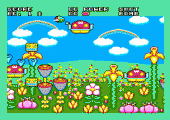
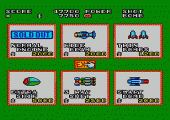
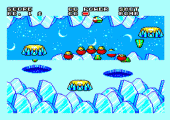
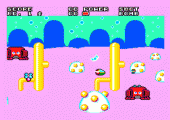
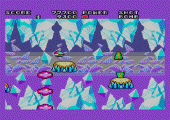
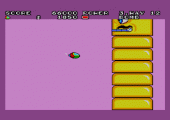
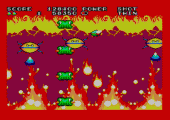
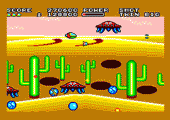

This was one of my favorites. I thought it was a good example of the power the Master System had. You couldn’t do this game on an NES. I loved the soundtrack as well. No FM sound chip. I loved the Master System sound chip the way it was. I’d give this game a solid 8 easily. What a challenge as well. Lots of enemies to navigate and levels to go along with it. It felt like with both Fantasy Zone 1 & 2, the on screen colors were maxed. These 2 games were great.